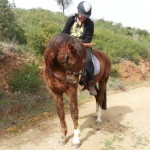 Halfway up the hill the energy, hers, pulsing through my legs and loins suddenly surges and I am immediately conscious of a change of pace. We are trotting. No, I have not asked this of her yet I feel no need to slow her down. Clearly, she is more comfortable with this. And if she is, so am I. Yet this is so very new to me, the absence of the familiar tools of control, those reassuring devices, sources of apparent safety. I relax, initially far too consciously. Let go, I think to myself, let your body sink into her ryhthm. Then and only then do we find each other on the ascent to the summit. There she stops, inclines her head towards me, her eye seeking mine. And I sit upon her and marvel … at her … at me … at what we have just done.
Halfway up the hill the energy, hers, pulsing through my legs and loins suddenly surges and I am immediately conscious of a change of pace. We are trotting. No, I have not asked this of her yet I feel no need to slow her down. Clearly, she is more comfortable with this. And if she is, so am I. Yet this is so very new to me, the absence of the familiar tools of control, those reassuring devices, sources of apparent safety. I relax, initially far too consciously. Let go, I think to myself, let your body sink into her ryhthm. Then and only then do we find each other on the ascent to the summit. There she stops, inclines her head towards me, her eye seeking mine. And I sit upon her and marvel … at her … at me … at what we have just done.
Awe
And just what is it that we have done? I look down at Pip’s back to where creases of white smudges her chestnut coat. A saddle must have left its mark there at some stage. Today there is none, nor are there any stirrups, and similarly no bit. The reins loop gently from my hand to the noseband of her cavesson. There is no need for pressure.
Below us the hard earth is pocked with small stones on either side of a zig-zagging rut. To the left rocks protrude from a rising embankment, while the land falls steeply to the right. This is only the third time I have burdened my mare with my body and the fith time I have been on the back of a horse in seventeen years. And I am doing this without any tack worth mentioning in connection with basic safety. I must be mad.
And yet I feel so utterly safe, more so than at any time since I first mounted a horse at the age of fourteen. How is this possible? It is a question that stays with me for days afterwards even though the answer asserted itself almost immediately. It was there in her eyes, when my mare looked back at the man on her back after our very first trot in the open countryside. Trust, it is a mutual thing, is it not?
But what was in it for Pip? What did she get out of the experience, if anything? I really cannot answer for my mare but merely report what I saw. And when I gaze into the memory of that spell upon her back, I see her, ears forward, eyes bright, jauntily powering along under the spring sun with the scent of the wild flowers fresh in their colourful presence lining the path. If there is a single word that captures her demeanour at the time, “perky” is the one that springs to mind. And it occurs to me that perhaps I was not so much riding her as she was bearing me.
Experience and riding
Klaus Ferdinand Hempfling introduces the book that, more than any other, helped launch his career, with a very moving yet extremely telling story about horse riding, one that many of us may wish to stop and ponder. The book is Dancing with Horses and the story, as Hempfling tells it so movingly with the help of that gifted translator, Christina McCormack, is this:
He was a noble caballero whose entire life had been devoted to horses. Not only was it said of him that he was a very dignified and humble man, but everyone who saw him ride was enthralled by the performance, and deeply moved by his riding ability.
At the age of ninety-six years, as he lay on his deathbed, he called for his nephew to come to him so that he might bid him farewell. And so it happened: as the nephew was finally turning away to leave the room he saw, for the first time, tears in his uncle’s eyes. The old man reached out again for the younger man’s hand and said softly: “It is such a misfortune that I must die just now”.
“Why?” asked his nephew, tenderly stroking the old man”s hand. “This time comes for every man, and you have had a long, rich, blessed life”.
“Yes”, said the old one, “you are right, but it was only about a week ago that I first realised what it means to truly ride a horse”.
(Klaus Ferdinand Hempfling, Dancing with Horses, p. 7)
Truly riding
So what exactly does it mean to truly ride a horse? Does it refer to technical proficiency? And if it does, which school, discipline or style would best exemplify it? Arguably, haute ecole would represent the summit of technically proficient riding but then would we opt for the Spanish school of riding with its reliance on pressure and release, essentially making the horse move with a bit in its mouth, or should we laud Alexander Nevzorov’s ability to execute high school movements – with the exception of lateral work – astride his black stallion, relying on little more than a neck ring, isolation of horse and human, and heaps of positive reinforcement?
Or is the art of truly riding a horse to be discovered and realised in something utterly different? Could it lie in the essence of the approaches epitomised – as I understand them – by the two horse people who have been so instrumental either directly or indirectly in helping me to shape my own approach. I am referring of course to Michael Bevilacqua and Klaus Ferdinand Hempfling.
Although these two men have been at the outer ends of the spectrum in their dealings with the public, Hempfling so in one’s face and Bevilacqua so self-effacing, they have had much in common in their approach to horses in general and riding in particular, at least until Bevilacqua decided against mounting a horse ever again. To both of them riding is a special experience which can only be meaningful if it occurs with awareness and sensitivity, which effectively means that it is practised sparingly and with concern for the horse’s wellbeing. In Bevilacqua’s words, “riding became just a tiny part of what was possible” (Beyond the Dream Horse, p. 68). As, if not more importantly, riding presupposes a close relationship betweeen horse and human which transcended technical proficiency, requiring that the species not merely have contact and communication with each other but that they also unite to form two parts of a single interactive being representing more than the sum of its parts in terms of energy, grace, agility and ceativity.
And with the horses who helped them achieve this arguably better than any other – Bevilacqua with Leo and Hempfling with Janosch (both geldings, it may be noted) – they managed to ride and/or interact with them closely even in the presence of other horses without any tack (Hemplfling) or no more than a neck ring and a twig (Bevilacqua), which presupposes the existence of an uncanny level of mutual trust on the part of both horse and human. Or perhaps this appearance of mutual trust is simply a reflection of the merging of two spirits in the creature created by the union of horse and human.
The past
When horses entered my life when I was about fourteen years of age, they were introduced to me as a mode of conveyance with the human bum and the horse’s back serving as the primary interface between the species, very much like a bicycle but less smooth and without a device resembling a reliable brake. Where a horse differed from a bicycle, a distinction could be conveniently drawn between advantages and disadvantages.
Initially, the disadvantages were more obvious. The four-legged creatures were definitely high-maintenance assets, completely unpredictable and potentially hazardous in the extreme. As if this was not bad enough, they were both capital and labour-intensive, they had no reliable brakes, their second gear was so choppy it required a fair amount of work and energy on the part of the rider to retain any sense of dignity in the saddle, and they had a tendency to behave like a loose cannon at odd times, bolting uncontrollably for no rhyme or reason usually at an inopportune moment. Indeed, the level of controlled chaos that seemed to surround horses required that one develop some of the survival techniques of a stuntman.
By comparison, the advantages were few. But what they lacked in number, they made up for in quality and versatility. From a technical point of view, they could negotiate terrain which no manmade vehicle was capable of traversing in addition to that which they were. They were also semi-amphibious and capable of brief bursts of flight without the need for wings. And they could convey you at a speed which not only allowed you to cover the distance from A to B in a relatively short space of time but could do so in a way that left you breathless with excitement.
Then there were the ancillary benefits. The opportunity to socialise with friends and acquaintances was an important one along with the attendant benefit of meeting new people. An afternoon on an outride with a group of friends also represented a significant extension of the limited freedom I enjoyed. Not least, there were the girls, many of them. In fact, most of the people of my age who had anything to do with horses were female. Being well into my teenage years with an insatiable curiosity concerning and attraction to the opposite sex, I was not about to object to such odds. The question of whether I was truly riding or not was the least of my concerns.
My own horse
Yes, you can own a horse as an object but when you consider the creature in all their live, vibrant energetical forms, can they really and truly be owned by anyone? Yet this is a question that was still years from where I was by the stage when I finally had the resources that allowed me to own and accommodate a horse. I was forty years old when this huge, eight-year-old, bay gelding entered my life in response to my plea for a horse of my own. Feeling like a Lilliputer in his presence, I dubbed him Gulliver, a name which he grew into as my understanding of him evolved over the next nineteen years.
Gulliver’s start to life was challenging. He was cursed with poor conformation, which is now contributing to the physical difficulties that he is encountering in old age. On top of this, for five of his first eight years on this earth he was abandoned in a large bit of wilderness, where he was left to fend for himself. I will not go into the details of his appearance when he finally emerged from it. Let your imagination run riot and it will most assuredly approximate the truth.
Although I took lessons, I was far from being a natural in the saddle. Additionally, Gulliver’s condition meant that he had difficulties supporting a rider, the countless times he dumped me when he stumbled being rude testimony to this. With hindsight, we should have started out on the ground but no one had taught me that, with the exception of mindless longeing, no meaningful interaction between horse and human was really possible out of the saddle or so it seemed at the time.
Yet, as our relationship improved and Gulliver’s body grew stronger, we enjoyed many lovely moments hacking out in the Australian wilderness together. And then we moved to the Sunshine Coast hinterland, where we built our first self-designed riding manège in maginificent forrested surroundings. Over time I became bored. I simply could not understand why I was supposed to be enthusiastic about jumping through so many hoops and hurdles in order to force a horse to do or desist from doing something in some or other way. Anyone could learn to do that to some or other degree. What was the point?
Shaman
About seventeen years have passed since I stopped riding Gulliver. Since then I have ridden a horse five times. The first was a trail ride in about 2002, when I accompanied guests at the local trail riding centre. Although it was pleasant enough to traipse through the lush green hills of the Sunshine Coast hinterland, the experience was not enough to persuade me to return to horses, let alone riding.
Viewing Hempfling astride Janosch five years later, the spirits of the two species merged to create the real-world equivalent of the mythical centaur, prompted me to take the first few steps on a new path towards the horse. Much of that journey is chronicled in this blog. By the time I next sat astride a horse I knew that I could only do so if I had a connection with them.
And I did. The horse’s name was Shaman, a fortuitous coincidence I thought, given in part that he was the strongest horse in the Equinatural herd, displaying stallion-like behaviour on occasion even after being gelded (a euphemism for “castrated”). And again, the occasion was a desire to accompany a guest on a trail ride. It was last year. Before I ventured to do the same with Pip, I needed to know whether I could still ride, whether it would be different and, if so, how. Although I rode Shaman bitless, when given a choice, I rode him in a hackamore. With hindsight, there was no need to.
Shaman behaved like a guardian angel. Alert to my successes and failings in equal measure, he heeded my requests when he understood them and cradled me in his care whenever he did not. There was no need for pressure or force, if there ever is. Shaman is a horse who has a reputation for being capable of sudden violence with other horses and even the odd human. Interestingly, this is a side of him I have only seen once, when he chased Pip away from “his” pile of hay, and never in relation to a human. I attribute his concern and care for me to the times that we have spent together hanging out in the field without any agenda, just doing what friends do.
Pip
It was Vicki who took the initiative. I had known that Pip and I were fast moving towards a situation in which it would be possible to contemplate riding her. Not only was she moving straighter thanks to a holistic approach of straightness training, Equine Touch and, especially over the past nine months, remedial trimming. “You’ve reached your target weight,” Vicki said to me one day, “I think you should get on her today.” So I did. Finally, I was below seventy-five kilogram ceiling we had agreed would be appropriate for Pip.
The first time I mounted my mare was in the outdoor manège. Vicki led Pip on a lead and I focused on rediscovering my balance with nothing more than a saddle cloth and pad separating my body from my mare’s. At a certain point I recall letting myself go and just sinking into the rhythm of her movement without making any attempt to align mine with hers. The effect was electrifying. Never before have I been not only so aware of Pip’s energy, I could also feel it coursing up my legs, through my loins and into my very core. And if I am feeling this, what is my mare experiencing, she who is that much more sensitive than I will probably ever be?
Over the next few weeks I rode Pip on two further occasions with about one to two weeks in between all three sessions. On the latter two occasions we went out into the countryside. The first time Vicki led Pip on a lead, while walking Anaïs. By the end of the outing Pip and I were travelling solo. It therefore felt like an entirely natural progression, when Vicki suggested that the four of us go on a trail ride together. And it was during that outride that I finally realised the enormity of what Pip and I had achieved. But just what had we achieved?
The merging of two spirits?
Shared energy. This is what it is. And if energy is the essence of the spirit, is not riding truly the merging of two spirits? What then is the creation that arises when horse and human spirits merge and move as one? Could it be the essence of what the caballero meant when he declared on his death bed that he had, at the age of ninety-six, “first realised what it means to truly ride a horse”? This is not to suggest for a moment that I have discovered what “truly riding” is, assuming that it is an objective state which one can ultimately attain and be seen to have done so. But what if it is not? What if truly riding is a subjective experience for both horse and human, a shared encounter to which only they are privy?
To someone who has not had the experience, it is difficult to explain the sense of wonder and awe which a horse can occasion in a human when either responds to the minutest clear shift in the other’s energy while physically connected through riding, especially when such a response occurs intuitively in the moment without rational reflection. Until I mounted Pip, I had only experienced such moments on the ground in the absence of direct physical contact but even then only with our own horses in the past few years and to a far more limited extent than when mounted. Astride my mare, not only is the range of interaction between horse and human greater and more varied, so too is the spectrum of intensity, although in the latter case the difference between the ground and mounted experience is more limited.
Which brings me to the years of groundwork which Pip and I shared before she allowed me to mount and ride her. Hempfling is absolutely right when he stresses the need to get everything right on the ground before venturing into the saddle, so much so that in his book, Dancing with Horses, he candidly rejects the possibility of riding properly in the absence of preparation on the ground (see the fairly lengthy section on riding). Such preparation makes it possible for horse and human to develop the relationship with each other without which nothing meaningful is possible between the species, according to Hempfling, along with the development of the body and spiritual awareness in the human which he claims to be an absolute prerequisite for any equally meaningful interaction between them. I am convinced that it is precisely this type of preparation which has brought Pip and I so far in three short rides.
All of the questions of insecurity, becoming acquainted, trust and understanding when interacting with a horse must come before you first get on the horse – before riding – because only then can they be really treated and answered. Being on the horse is just harvesting the fruits. On the horse, you can no longer thoroughly heal and no longer thoroughly correct.
(Klaus Ferdinand Hempfling, The Horse Seeks Me, p. 320)
Guilt or joy?
A horse is not made to be ridden by a human and riding one can cause injury. Although this is a commonly accepted physiological fact (especially amongst equine health care practitioners), it is one which the vast majority of humans who have anything to do with horses choose to ignore for one reason or another. Have I not done the same by riding Pip and should I not therefore feel guilt and remorse?
To be honest, this is a question that I deem to be utterly irrelevant. In all my non-urgent dealings with Pip I allow myself to be guided by what she finds acceptable and, provided that I am sensitive to the various ways in which she communicates with me, she lets me know precisely what is and what is not. True, much depends on the way in which any request is posed. Nevertheless, I am prepared to stop whatever it is I am doing, if she shows me that it is unacceptable. Asking her to allow me to ride her is no different. Although I have stipulated the caveat that this is confined to “non-urgent” matters, it is my experience that Pip immediately senses any urgency, especially if it concerns her health, and usually goes along with anything I feel is essential at the time.
Pip’s acceptance is a prerequisite for riding, not only for her sake but also for mine. How could I possibly feel the joy I do when astride her, if I am aware that she finds it unacceptable and is resisting and objecting as a result? It is simply impossible. Yet in order to play it safe and protect my mare, I have set myself a weight ceiling, and have committed myself to limiting my riding spells without a break to about fifteen to twenty minutes and an overall session to a maximum of two spells with a grazing break in between. At present I am looking for a treed saddle, which will distribute my weight evenly along those parts of Pip’s back which are capable of supporting me. Together with Vicki I am also doing a saddle-fitting course, as part of which finding a saddle for Pip will feature as a great practical project. We fly to France to do the practical component next month. Then I go in search of a saddle.
To ride or not to ride?
And yet I sense you hesitate. Great horse people, such as Alexander Nevorov and Michael Bevilacqua have decided against riding, because they believe it is not in the interests of the horse to do so. Should we not be following their example?
If the horses have taught me anything, it is that there is no such thing as a single solution, method, approach or the like which will fit them all. Like humans, all horses are unique. Some may embrace the opportunity to bear their human. Others may abhor the very notion. What is important in this respect is to allow the horse to express themeselves, to heed what they show us, and to act accordingly. In doing so, honesty and integrity are everything.
Yet there is another aspect which I have already hinted at and it is something which Hempfling has highlighted on a number of occasions. It is this. Together a willing human and an equally willing horse are capable of merging their spirits through the art of truly riding to produce an energetical symphony of beauty, athleticism and creativity, which excels what each could possibly achieve alone. This is the dance of horse and human which has beckoned us for thousands of years. How many of us are capable of partnering the horse in the joyful celebration of such an achievement? How many of us would genuinely want to try?
Of course, however true this might be, to most of us ordinary mortals this seems to be the preserve of a select minority of truly gifted horse humans, those who appear to be capable of dancing with horses in a magical, mystical manner and whose prowess, is almost by definition out of our reach. So, if we know this to be the case, why should we, the great untalented unwashed, want to ride a horse and be acknowledged as caring owners when doing so, even if it is only we ourselves who are responsible for such acknowledgement?
There is a very simple reason for this and it is this. When we remove horses from the wild and place them in captivity, even in the most benign situations it is quite likely that we deprive them of what is arguably the most important activity which is responsible for their physical and ultimately emotional well-being, namely, the ability to move up to thirty-five kilometres (a little under twenty-two miles) or more a day. It is simply impossible for a human who is subject to the pressure of time, as most of us are – not to mention any other pressures or incapacity – to provide horses in captivity with anywhere near a similar amount of movement without riding them, and the failure to do so may cause more harm to the horse than riding the creature. Having said that, how we ride a horse in a situation such as this, is as essential to their well-being as is their need for movement, and this is dealt with elsewhere in this post.
The icing on the cake
As I contemplate the merging of two spirits in the dance of truly riding, I am mindful of Bevilacqua’s observation of riding becoming “just a tiny part of what was possible” and also of Hempfing’s “iceberg” of riding, in which “riding is its smallest part” (The Horse Seeks Me, p. 315 – see my post entitled Hempfling’s Iceberg and Pip’s Sea). To Hempfling riding is simply a destination which we may or may not achieve, for it is the journey which is really the goal. If it is ever reached, it is merely the icing on the cake, as it were, but oh, how sweet that icing can be if if remains just that.
To remain with the same metaphor, once truly loved by their human in deed as well as word, do not horses allow us to have our cake and eat it too? Is there not so much the species can share with each other, that essentially it is possible for horse and human to enjoy the most rewarding relationship with each other without any need for a bum-back interface? And if there is, why then should we not confine riding, should it ever occur to just such icing? This is essentially the dimension to which I would like to confine riding. Only in this way, I believe, will I ever have the chance to truly learn to ride and, more importantly, will it provide my equine friend with the protection she requires from otherwise premature injury and untimely death as she grows older.
The icing, so deliciously sweet and heady, which Pip has given me, has come just before a special month. In April both of us are celebrating the close of yet another year of life on this beautiful earth. The start of the month also marks four years since Pip entered my life. In this context it is difficult to resist the temptation to view riding her as a special gift from the horse. Although this may indeed be the case, I am inclined to resist the temptation to view it as such, for all too often we humans have a tendency to explain away our actions and hence our responsibilty for them by attributing them to the horse. This I do not wish to do.
As I relive yet again the moment on Pip’s back at the top of the hill after our first trot through the merging of spirits and marvel at what we have just achieved within three brief rides, I am conscious that it has taken us four years to reach this point. This may seem like an inordinately lengthy period of time. Yet, when I look around and see how many humans are taking shortcuts on horses’ backs and have been doing so for ten, fifteen or twenty years or more and still do not know what it means to truly ride a horse, I wonder whether a mere four years is really as long as it seems.
Horses and Humans on Facebook
May I remind you that we now have a Horses and Humans group on Facebook. If you would like to leave a comment, you can do so on this blog or on the the Horses and Humans Facebook group page. All new posts will feature on that page along with additional content posted by any of our members. Please feel free to join us at:
https://www.facebook.com/groups/horsesandhumans/
There is also a Horses and Humans publications page, which contains information concerning the publications released under the Horses and Humans imprint. Some of those publications will be free of charge. You will find it here:
https://www.facebook.com/horsesandhumans
I also have a Facebook page through which you may contact me. You will find it at:
https://www.facebook.com/andrewglynsmail
Equine Touch
Our Equine Touch business is called Humans for Horses, you can find our website at:
http://www.humansforhorses.com/
and our Facebook page at:

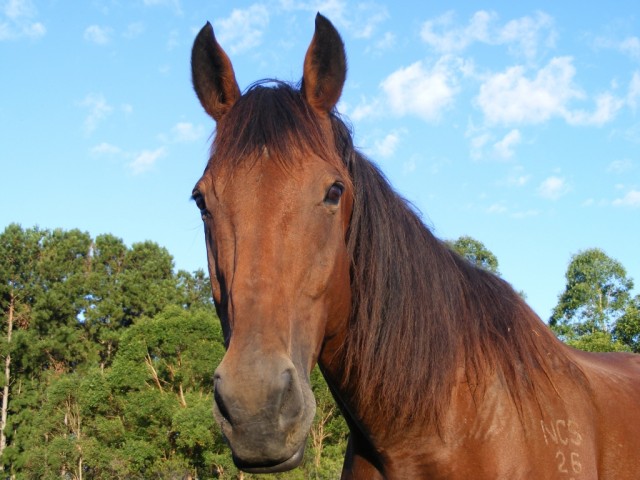
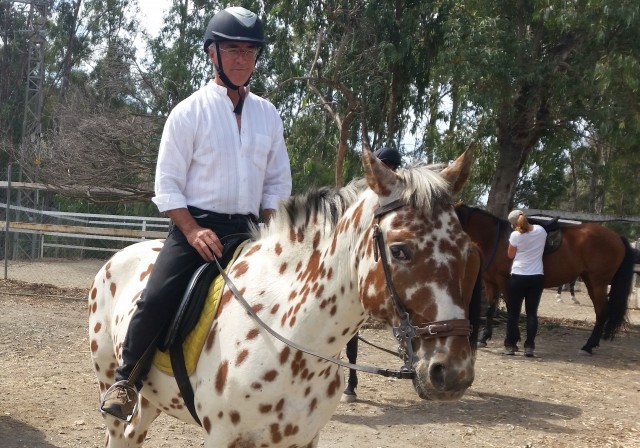
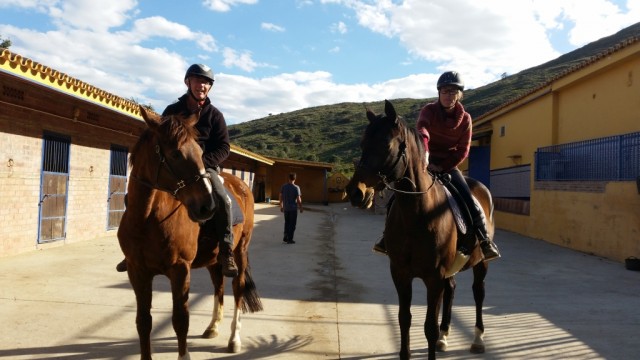
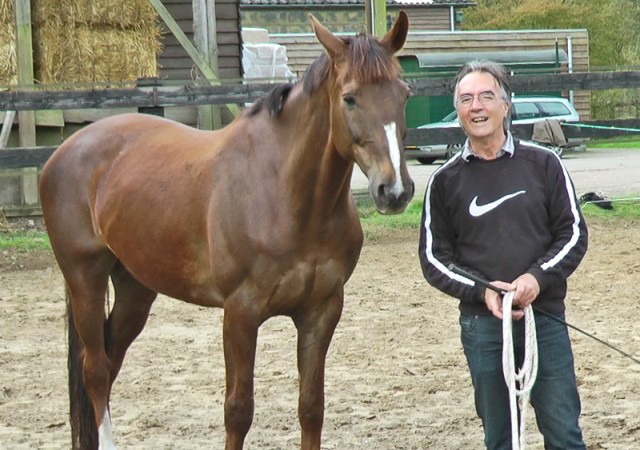
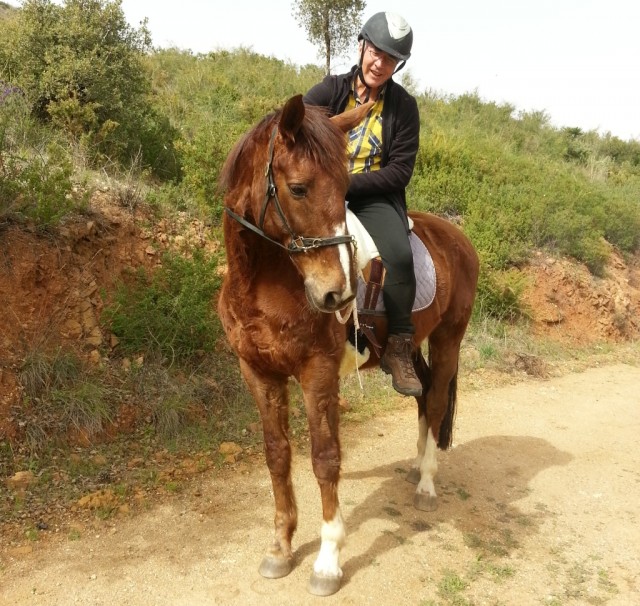



Great to see you riding Andrew! You both look very comfortable together!
Beautiful post, Andrew. I am so happy for you that Pip and you have come this far. And who knows how much further the two of you will continue travelling. Carpe Diem.
It’s a long read. I like the positive spin to it all. And reads like fun.
Bueno……
Dear Andrew,
That was lovely, I find it so refreshing when someone can put into words , so much better than myself, how I feel. I ride my horse maybe once a week sometimes a lot less, we work at liberty, ground work and in hand. My mare offers me her back and even asks if we can ride, she enjoys it, she loves to be close to me and loves touch, maybe that and the fact that we always merge as one, its as if she can sense my intentions and me hers, sometimes she has ideas about what she would like to do. She loves showing off how she can collect herself. She is a Lusitano! My other horse I have had for 18 months, she was in ridden work but it was an unhappy time for her. She had become dangerous as her message wasn’t getting through to her human. I have asked her if I may sit on her and she has said yes but only recently, movement or contact on anything like a halter is out of bounds still. Trust is growing, she is more energetically connected, she has a huge energy field and didn’t want me in it at the beginning, now she can walk up close at liberty but she can always choose. I don’t care if we never have a ridden relationship, it truly is just the icing on the cake. If you only want the icing you are missing the delicious cake, the mixing and the baking. Thank you for such a great piece and sharing. Love Jayne.
Thank you, Andrew, for this honest, insightful article. It deeply resonates with me. I am now doing my third online series of seminars with KFH about personal development and self mastery. It is eye opening and, yes, life changing. But the most life changing were his books I read recently: The Message from the Horse, Der Pferdeschamane and Frau und Pferd. Thanks to my multilingual background, I read those books in German and found them incredible. In the Message from the Horse, there was a rare opportunity to get a glimpse of Hempfling’s soul, his very essence, if one more felt than read his words. Der Pferdeschamane was written about him, not by him, however he had a major input in this book. To me, it is not anymore about even riding horses, it has become about how to be. I am privileged to be part of a herd of 8 horses, who are our cofacilitators in equine assisted therapy for survivors of sexual abuse. The horses always have a choice to participate or not to. All activities are ground based. And they are aimed at helping children and adults get to know themselves, rediscover their strengths and talents and being able to recognise their weaknesses and learn from them, live with them and see them as opportunities rather than hindrances.
I thoroughly enjoyed reading your article about your journey with your horses. The icing on the cake – enjoy it with Pip, it is well deserved 🙂
What a lovely article, and although I choose not to ride, if I were to I would want to do it the way you have! Thank you for sharing.